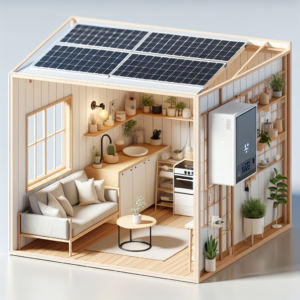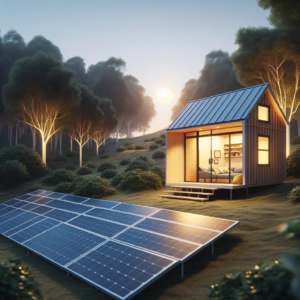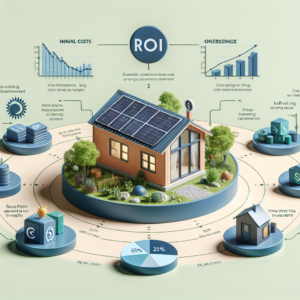
Key Takeaways
-
Understand your energy needs to select the right solar power setup for your tiny home.
-
The Goal Zero Yeti 3000X is a robust power station that can store and supply solar energy efficiently no matter what type of tiny home you have.
-
Positioning solar panels correctly is crucial for maximum energy absorption from the sun.
-
Regular maintenance of your solar power system ensures longevity and peak performance.
-
Having a backup plan is essential for times when solar charging isn’t possible.
Harvesting the Sun: A Must for Tiny Home Dwellers With
Living off-grid doesn’t mean giving up on modern conveniences; it means adapting to a sustainable lifestyle. Solar power is the cornerstone of this transition, offering a way to keep the lights on and appliances running without a traditional power grid. It’s not just about being eco-friendly—it’s about self-sufficiency and independence.
Embracing the tiny home lifestyle means making the most of every resource, and when it comes to power, there’s no better ally than the sun. Solar energy is clean, abundant, and, most importantly, free once you have the right equipment. I’ll guide you through the ins and outs of harvesting solar power to run your off-grid tiny home, focusing on the capabilities and advantages of the Goal Zero Yeti 3000X portable power station.
Why Solar Power is a Game-Changer for Living Small
But it’s not just about the economics. Solar power also ensures that your tiny home can journey to be nestled the most remote locations. Where ever you are, the sun is your constant companion, providing power through thick and thin.
And when it comes to reliability, solar power has made leaps and bounds. With modern technology like the Yeti 3000X, you can store enough energy to keep your home powered up even when the sun sets or during cloudy days.
The Goal Zero Yeti 3000X Advantage: Big Power in a Small Package

The Yeti 3000X isn’t just any solar power station; it’s a compact powerhouse. With a 2000-Watt AC inverter and a lithium-ion battery core, it’s designed to meet the high demands of tiny home living. Here’s what makes it stand out:
-
Integrated MPPT charge controller for efficient solar charging.
-
Multiple charging methods, including solar, wall outlet, and car charging.
-
Various output ports to power a wide range of devices and appliances.
Imagine a device that not only stores enough energy to power your entire home but also charges quickly from the sun—this is the Goal Zero Yeti 3000X. In as little as 6 hours of sunlight, you can harness enough power to keep your tiny home running smoothly.
Getting Started with Solar Power
Before you dive into the world of solar power, you need to understand your energy needs. This means taking stock of the devices and appliances you use on a daily basis and how much power they consume. It’s not as daunting as it sounds, and I’ll walk you through the process step by step.
Assessing Your Energy Needs
Begin by listing every electrical device you’ll use in your tiny home. From lights to laptops, fridges to fans, each item’s power requirements will determine the size and capacity of your solar power system. Remember, it’s not just about the number of devices, but how often and how long you use them.
Once you have your list, look for the wattage of each item—usually found on the device or in the manual—and calculate the total power you’ll use in a day. For example, if you have a light that uses 10 watts and you use it for 5 hours a day, that’s 50 watt-hours per day just for lighting.
After tallying up the power usage for all your devices, add a margin of safety. I recommend increasing your total by 20-25% to account for inefficiencies and unexpected power needs. This gives you a clear picture of the minimum battery capacity you’ll need in a solar power station like the Yeti 3000X.
Battery Specs and Capacity: What Does the Yeti 3000X Offer?
The Yeti 3000X is a beast when it comes to storing power. With a 3032Wh lithium-ion battery at its core, it can keep your tiny home humming without a hitch. This means you can run your fridge, charge your devices, and still have enough juice to power a cozy movie night with your LED projector. The beauty of the Yeti 3000X is its ability to hold a substantial charge, giving you the freedom to live comfortably off-grid.
Charging Your Yeti: Solar and Other Methods
Charging the Yeti 3000X is a breeze. While solar is the most sustainable option, you’re not limited to it. You can charge your Yeti in three different ways:
-
Solar: Connect it to compatible solar panels. The charge time will depend on the panel’s size, but with the right setup, you can go from zero to full in as little as 6 hours of sunlight.
-
Wall Outlet: Plug it into any standard wall outlet to fully charge in about 14 hours. This is a great option to top off your power station before heading off-grid.
-
Car Charging: Use the Yeti 12V car charging cable to charge from your vehicle’s 12V adapter. It’s a handy method for road trips or when you’re on the move.
With these charging methods, the Yeti 3000X offers unparalleled flexibility, ensuring that you can keep your power station ready for whatever comes your way.
Understanding the Yeti’s Display and Controls
The Goal Zero Yeti 3000X is user-friendly, with a display that shows you everything you need to know at a glance. You can monitor your power input and output, check battery levels, and even see how much energy your solar panels are generating. The controls are intuitive, allowing you to manage your power usage efficiently. It’s like having a mini power grid at your fingertips.
Optimizing Your Solar Setup
Getting the most out of your solar panels involves more than just setting them up and forgetting about them. To truly maximize their potential, you’ll want to:
-
Position them at an angle that catches the sun’s rays directly.
-
Avoid shading from trees or other structures, as this can significantly reduce their efficiency.
-
Consider the sun’s path and angle changes throughout the year and adjust accordingly.
By optimizing the placement of your solar panels, you’ll ensure that your Yeti 3000X is getting the maximum charge possible throughout the day.
Positioning Solar Panels for Maximum Efficiency
It’s essential to angle your solar panels correctly. The ideal angle is equal to your latitude, with adjustments made for seasonal shifts. During summer, you can tilt them lower, and in winter, angle them higher. This captures the most sunlight as the sun’s path changes. Also, keep in mind that solar panels perform best when they’re cool, so allow for airflow underneath to prevent overheating.
Yeti 3000X’s Role in Energy Management
The Yeti 3000X is not just a battery; it’s a smart energy management system. With its built-in MPPT charge controller, it maximizes the solar charge at all times. It also allows you to prioritize which devices get powered first and how much power they draw. This means you can ensure your most critical needs are met before anything else, like keeping the lights on and the water pump running.
Living with the Goal Zero Yeti 3000X
Integrating the Yeti 3000X into your tiny home life means embracing a new level of energy awareness. You’ll become more attuned to your power usage and how the sun’s cycles impact your daily routine. But it’s not all about adjustments; it’s about enjoying the freedom that off-grid power provides.
Real-life Applications: Running Your Tiny Home
Imagine powering your entire home with the sun. The Yeti 3000X makes this a reality. With its vast array of ports, you can connect everything from your smartphone to your kitchen appliances. For instance, you can run a mini-fridge for about 50 hours or a CPAP machine for over 40 nights on a single charge. It’s about having the power you need, when and where you need it.
The Yeti 3000X turns your tiny home into an oasis of modern comfort, no matter where you are.
What to Do When the Sun Doesn’t Shine: Backup Strategies
Even the best solar setups have their cloudy days. That’s why having a backup plan is crucial. The Yeti 3000X can be paired with additional batteries to extend its capacity. You can also keep a gas generator on hand for emergencies, though it defeats the purpose of clean energy. The best strategy is to conserve power during low-sunlight periods and plan your usage around the weather forecast.
By following these guidelines, you can ensure that your tiny home stays powered up, comfortable, and eco-friendly. The Yeti 3000X is more than just a power station—it’s a gateway to sustainable living. And with the right setup and maintenance, you can enjoy the benefits of solar power for years to come.
FAQs: Embracing Solar Power with the Goal Zero Yeti 3000X
1. How Long Does the Yeti 3000X Take to Charge via Solar?
The charging time for the Yeti 3000X via solar panels can vary based on several factors, including the size and efficiency of the panels, as well as the amount of sunlight available. With optimal conditions and the right setup, such as using three Nomad 200 Panels, the Yeti 3000X can be fully recharged in as little as 6 hours of sun exposure. However, it’s important to note that in less than ideal conditions, it could take longer.
2. Can the Yeti 3000X Power My Entire Tiny Home?
Yes, the Yeti 3000X has the capacity to power an entire tiny home, depending on your energy usage. It’s equipped with a 2000-Watt AC inverter and a 3032Wh lithium-ion battery, making it capable of running appliances and devices typical in a tiny home setting. To ensure it meets your needs, calculate your daily power consumption and compare it with the Yeti 3000X’s output and storage capabilities.
For example, the Yeti 3000X can run a 50W fridge for about 60 hours, charge a smartphone over 150 times, or power a laptop for 50+ hours. But remember, usage of multiple devices at once will draw more power from the unit and reduce the overall run time.
3. What Maintenance Does the Yeti 3000X Require?
Maintenance for the Yeti 3000X is minimal but crucial for longevity and performance. Here’s what you should regularly do:
-
Keep the unit and solar panels clean from dust and debris.
-
Ensure the battery is charged every 3-6 months when not in use.
-
Store the Yeti 3000X in a cool, dry place, avoiding extreme temperatures.
By following these simple steps, you can keep your Yeti 3000X running efficiently for years.
4. Is the Yeti 3000X Portable Enough for Travel?
While the Yeti 3000X is one of the larger power stations in the Goal Zero lineup, it is still designed with portability in mind. It weighs about 69 lbs (31 kg), which is manageable for most people to transport. It’s equipped with a sturdy handle and can be moved to different locations in your tiny home or taken with you for off-grid adventures. However, it’s not as light as smaller models, so consider your own mobility needs when planning to travel with the Yeti 3000X.
5. How Does Weather Affect Solar Charging Efficiency?
Weather plays a significant role in the efficiency of solar charging. The Yeti 3000X’s charging time can be affected by:
-
Cloud cover, which can reduce the amount of sunlight hitting the panels.
-
Rain or snow, which can obstruct the panels’ surface and decrease performance.
-
Extreme temperatures, as excessive heat can reduce the efficiency of solar panels.
To mitigate these effects, always position your solar panels in the most sun-exposed location possible and maintain them regularly to keep them clean and clear of obstructions.
In conclusion, the Yeti 3000X is a versatile and powerful tool for maximizing solar power in off-grid tiny homes. By understanding your energy needs, positioning solar panels effectively, and maintaining your power station, you can ensure a reliable and sustainable energy source for your tiny home lifestyle. Embrace the freedom and independence that solar power brings, and enjoy the comforts of home wherever you may be.



